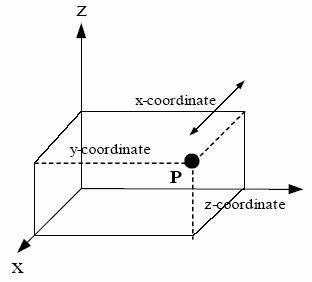Newton founded classical mechanics on the view that space is something distinct from matter and that time passes uniformly at every point in space, without regard to whatever happens in the world. For this reason he spoke of absolute space and absolute time, so as to distinguish these entities from the various ways by which we measure them. Space had three dimensions – the normal directions of three dimensional space, and time threaded the whole of space and moved uniformly at the same rate throughout space.
 >
>
Each event P could be uniquely labelled by three space and one time coordinate,![]() and all observers could agree on the coordinates of each event.
and all observers could agree on the coordinates of each event.
From antiquity into the eighteenth century, contrary views which denied that space and time are real entities maintained that the world is necessarily a material plenum. Concerning space, they held that the idea of empty space is a conceptual impossibility. Space is nothing but an abstraction we use to compare different arrangements of the bodies constituting the plenum. Concerning time, they insisted, there can be no lapse of time without change occurring somewhere. Time is merely a measure of the cycles of change within the world.
Associated with these issues about the status of space and time was the question of the nature of true motion. Newton defined the true motion of a body to be its motion through absolute space. Those who, before or shortly after Newton, rejected the reality of space, did not necessarily deny that there is a fact of the matter as to the state true motion of any given body. They thought rather that the concept of true motion could be analyzed in terms of the specifics of the relative motions or the causes thereof. The difficulty (or, as Newton alleged, the impossibility) of so doing constituted for Newton a strong argument for the existence of absolute space.
